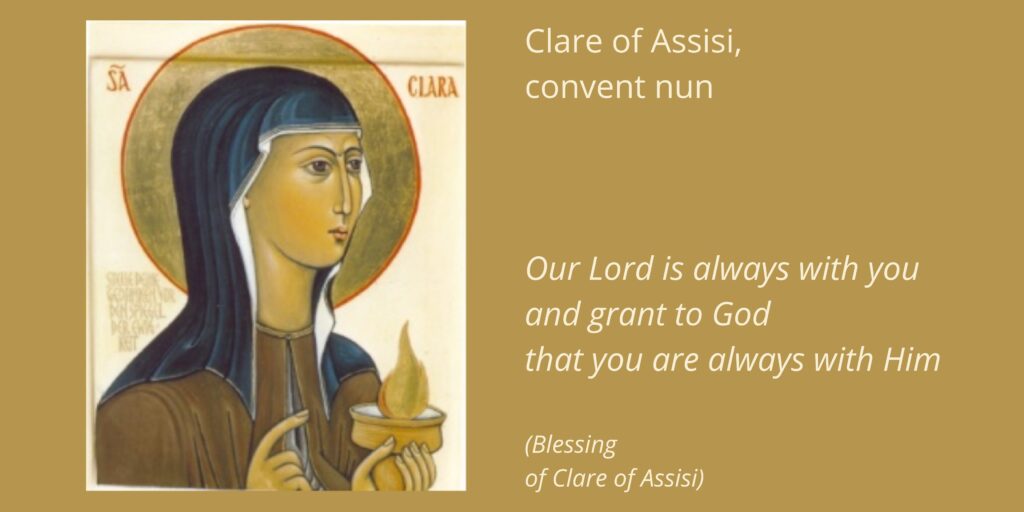
Clare of Assisi was born on July 16, 1194, the daughter of the nobleman Favarone di Offreduccio di Bernadino. Under the influence of Francis of Assisi and with his help, she left her parental home and devoted herself to following Christ in radical poverty.
With Francis, she founded the « Order of Poor Ladies ».
Until her death, Clare stayed in San Damiano and lived there according to the ‘monastic rule’ that she herself wrote as the first woman in history. Pope Innocent IV only approved this rule on her deathbed. She died on 11 August 1253. She is buried in the Basilica di Santa Chiara, Assisi, Italy, near Franciscus of Assisi. Two years after her death, Pope Alexander IV canonized her.
Clare’s origin
At the end of the twelfth century, in 1194, Clare Favarone di Offreduccio was born into a noble family in Assisi (northern Italy). The name Clare means: the radiant, the luminous. She was the eldest daughter and had two sisters: Catarina and Beatrix. Her father, one of the five knights of the Offeduccio family, was hardly ever at home. Her uncle Monaldo represented authority in the family. Clare’s mother, Ortolana, was a strong woman. She is known to have made pilgrimages to the Holy Land, to the tombs of the apostles in Rome and to the sanctuary of Saint Michael in Apulia. These pilgrimages certainly testify to her entrepreneurial spirit and later it will become apparent that they are no strangers to Clare either.
Like all noble girls, Clare had a solid education. She learned to read and write, mastered Latin well, learned to organize a household and also spinning, weaving and embroidery. She knew how to deal with people from the highest circles. As a child and young girl, Clare was very affable and sensitive to the needs of others. She distributed food to the poor and paid attention to the sick. She prayed a lot and fasted strictly. It was clear to her that she would not be married off. She chose a life devoted to God.
Who was Clare of Assisi?
Why is Clare still spoken of after so many centuries? It is very surprising, because her life took place for more than 40 years in the secrecy of the monastery of San Damiano, just outside Assisi.
She was extremely fascinated by Francis of Assisi and the remarkable way in which he was going to live according to the Gospel: free from possessions, being completely open to God and to the people he meets. Clare wants to follow him on that road and takes the big leap.
In 1212, on the night after Palm Sunday, she runs away from home. That same night she is admitted to the order in the little church of Portiuncula.
She was the first woman to join Francis. She soon moved into a simple monastery that Francis had built near the San Damiano church outside the city walls of Assisi. Clare led there an extremely sober and prayerful life for more than forty years.
Clare’s followers
Soon a number of young women joined Clare. She was eighteen years old by then. In her youthful enthusiasm, this noble young lady could not have imagined that her desire to go through life in prayer and without any possessions would encounter so much resistance from the ecclesiastical authorities of that time.
In 1238 the community consisted of 50 sisters.
For forty years Clare and her sisters have worked to establish a right to exist within the Church for their new form of evangelical life. She shaped the Franciscan spirituality in her own way. She and her sisters live in the seclusion of the monastery, in a spirit of manual labor, silence, poverty and prayer. In the same open-mindedness as Francis, they live their lives full of joy in caring for each other and in communion with God and people, many of whom come to them for advice and prayer. That is where they find their wealth.
With respect, but boldly, Clare pointed out to the ecclesiastical authorities their first task: to preserve the gospel of Jesus Christ above all by example and then by proclamation. It is partly thanks to Clare, her fellow sisters and successors, that the original charisma of Francis has been preserved to this day.
Calling in communion with Christ
Clare was a strong woman, who firmly stood up for her vocation and way of life, even when she encountered misunderstanding from her environment and the ecclesiastical authorities.
She lived from a deep bond with Christ, which was expressed in a sisterly love that served her own community, for the Friars Minor and for everyone who came her way. In the silence of contemplation she went on a path of true incarnation, becoming a radiant light to all who met her.
Clare herself writes about this way: “Put your mind in the mirror of eternity, place your soul in the radiance of glory, place your heart in the image of God’s essence, and by contemplation transform yourself completely into the image of his divinity. Then you too will experience for yourself what the friends experience by tasting the hidden sweetness which God Himself has kept from the beginning for those who love Him.”
(From Clare’s 3rd letter to Agnes 12-14)
Clare’s Rule and Recognition
At the end of her life, Clare wrote, as the first woman in history, the “Way of Life for the Poor Ladies” which is valuable in essential points to this day. She wrote this on the basis of the Rule of 1223 from the Friars Minor. First of all for her own monastery, but also as a model for other monasteries. The ecclesiastical authorities, however, considered a life without any means of subsistence so risky that Clare received ecclesiastical recognition from Pope Innocent IV only on her deathbed, August 9, 1253, two days before her death. Clare knew then that the future was safe for the Poor Ladies and she could die in peace. Her last words were, “Blessed be thou Lord who hast created me.”
Two years after her death, she was canonized by Pope Alexander IV on September 26, 1255.
In practice, the “Way of Life for the Poor Ladies” caused quite a stir among the religious women’s movement of the time, with the result that Pope Urban IV wrote a new Rule in 1263 for all women’s monasteries that chose the monastery of San Damiano in Assisi as an example.
Heritage
Clare left a number of Writings. In addition to the Life Form mentioned, she wrote a Will and Blessing as a spiritual heritage for all her sisters.
From 1234 to 1253 she corresponded with Princess Agnes of Bohemia, who had founded a monastery of ‘Poor Ladies’ in Prague. Four letters of that correspondence, in which Clare supported Agnes in a sisterly way, have survived.
Clare now
To this day there are women all over the world who enthusiastically continue the contemplative way of life of Clare and her sisters. They desire to shape Clare’s original inspiration within their own culture and to share its spiritual richness: a simple life of prayer without much material security for tomorrow, silently listening to God and people, attentively looking at Christ, the other and everything created by God.
Clara is honoured annually on the date of her death, August 11.
The monastery of San Damiano and the tomb of Clare in the Basilica di Santa Chiara can be visited as a place of pilgrimage.
Sources:
- Wikipedia, websites Clarissen Netherlands and Belgium.
- Publication ‘Bij Clara’ by Gerard Pieter Freeman (1993).
- Publication ‘Samen Geroepen’ by sisters Clarissen Megen (2003-2004).
- Publication ‘Echt mens worden met Clara van Assisi’ by Francine Demarsin (1994)
- Publication ‘de Heilige Clara, leven’
- Writings, documents, introduced and translated by Hilarion Goossens OFM (1976).
Publication ‘Francis of Assisi, chapter 15’ by Adrian house (2013).
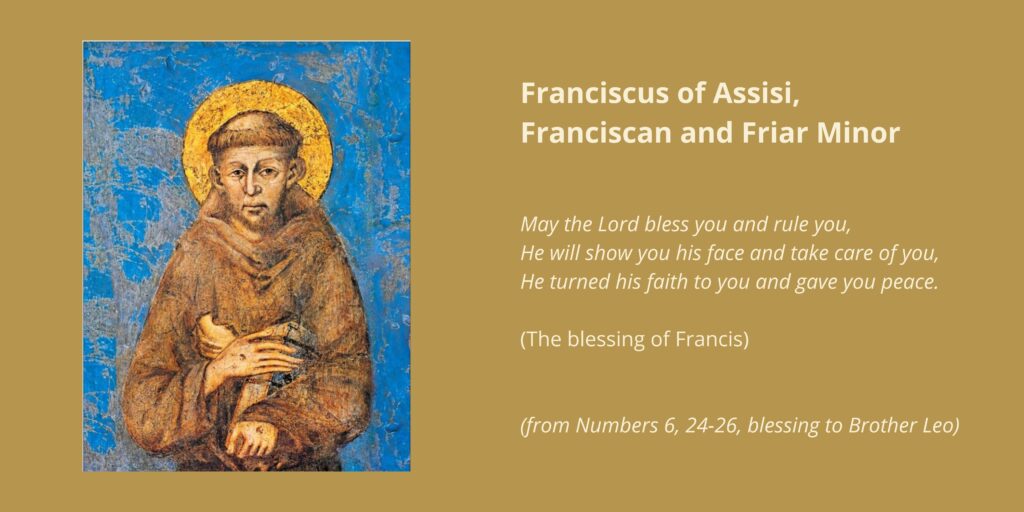
Francis of Assisi was born in 1181 or 1182. At first Francis dreamed of becoming a knight and around his twentieth year he fought for the nobility in a campaign against Assisi. This was a fiasco for Assisi and Francis was captured. When he was released, he had changed and concluded that he wanted to serve God. This conversion led Francis to live as a religious and he founded the monastic order of the Franciscans or Friars Minor. He died on October 3, 1226 in the Portiuncula at Assisi. Francis was canonized on July 16, 1228 by Pope Gregory IX.
Francis’ origin
In the second half of the twelfth century, in 1981 or 1182, Francis was born as the son of a merchant in Assisi (northern Italy). At his baptism he was given the name Giovanni di Pietro di Bernadone. But when his father Pietro di Bernadone returned a few days later from a trading trip in France, he named his son Francesco, the “French”.
Francis grew up in a prosperous environment. He learned to write and count at the parish school and went to help his father in the cloth shop. As a young man growing up, he looked ambitious: he wanted to become a knight or a great monarch. The knights wanted to keep the citizens under their control, while the citizens wanted freedom. While fighting, Francis saw that the number of the poor was increasing. There lay the seeds of Francis’ conversion.
Conversion
Francis fought in a campaign against Assisi. However, it was a fiasco for Assisi and Francis was captured. When he was released, he had changed; he was looking for a new meaning in life. In Spoleto he had a dream that showed that it was better to serve God. So he returned to Assisi and went to help the poor and lepers. It was there that his love of poverty was born; it turned out to be the decisive period for his conversion. He prayed a lot. One day at the chapel of San Damiano, he heard the crucifix say, “Go and mend my house. Can’t you see it’s a mess?’ He restored the little church and in that way found the building block for his life: the restoration of God’s house.
When the church was finished, he withdrew from his wealthy family and returned everything he had to his father.
He then restored the little church of Portiuncula, where he often stayed. The chapel owes its fame to Francis.
Followers of Francis
Around 1209 a number of men decided to share the way of life of Francis. They called on people to live an evangelical life. They called themselves Brothers of the Least or Friars Minor. When there were eleven brothers, Francis went with them to the Pope and with his approval they were allowed to preach about 1215.
In 1211 or 1212 a woman came to Francis: Clare. Clare wanted to follow his way of life. With Francis’ permission, she moved into the monastery near the church of San Damiano. Other women began to share her way of life. Later this would become the Order of the Clarisses.
There were also people who wanted to follow the ideal of Francis, but from ‘their own home’ and ‘married or not’ they often did merciful work and supported the Friars Minor and the Clarisses. They were called the seculars or the Franciscan lay order.
Health
Francis was the undisputed leader of his brothers. He made many preaching trips, also outside Italy, such as to Spain, Egypt and the Middle East.
Francis understood that leadership of the now expanding order, which was becoming one of the most important orders in the church, was of great importance. This required a different leadership style. He therefore handed over his duties to the new leader Petrus Catani (lawyer). When he died less than a year later, Brother Elias became the new leader. Francis did a great service to the order in 1223. He made a new, more succinct rule from the provisional rules that the brothers had drawn up during the chapters.
Francis’ health suffered from the far and long journeys he made, but that did not bother him: it was the poverty that he continued to love. At the end of his life, Francis struggled with a lot of pain and discomfort, visual impairment and depression.
Stigmata and death
When Francis received an apparition of the crucified angel and his hands, feet and side showed the marks of Christ on the cross, commonly called stigmata, Francis understood it as a signal from heaven that he had remained faithful to Christ.
Francis died on October 3, 1226 in the Portiuncula. As he died, he looked up blind-eyed to the cloudless blue sky of a perfect summer morning that suddenly shone with a dazzling light.
Source: Wikipedia, various websites about Francis, publication ‘Francis van Assisi’ by Adrian House (2013), publication ‘In the footsteps of Francis’ by Gerard Piter Freeman (2010).
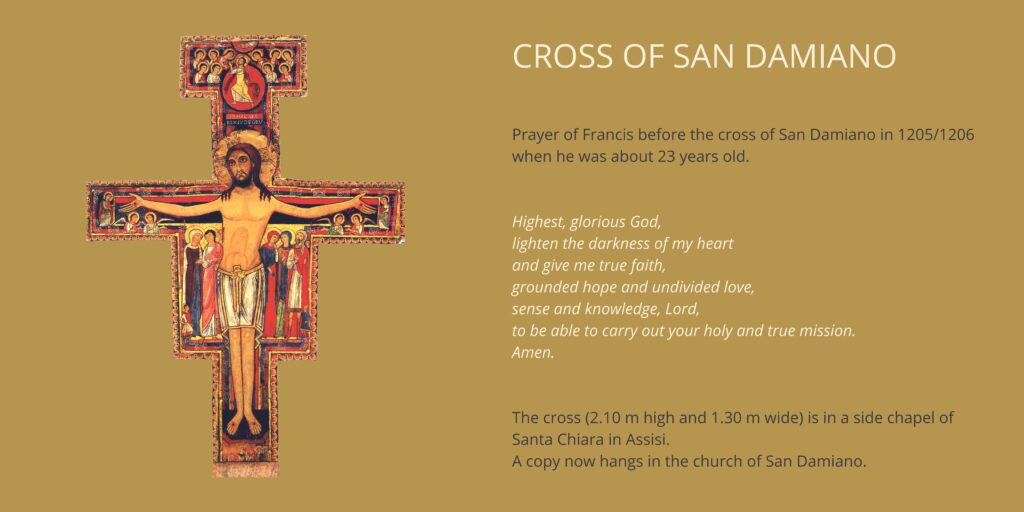
The cross of San Damiano is an icon painted by a Syrian monk around 1100. While painting, many texts have been incorporated into it: it is all symbolism. Suffering and death are transformed into glory on this cross.
Behind His outstretched arms is the empty tomb, as the pious women found it on the morning of His resurrection. On the far left and right are the women who come to the empty tomb
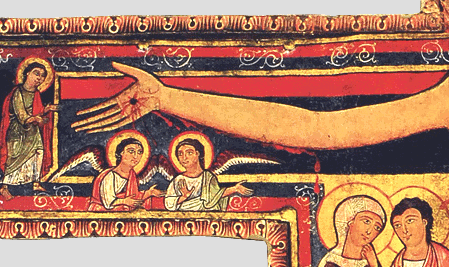
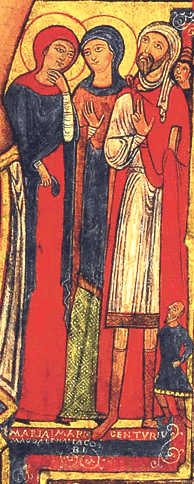
On the right of Jesus are Mary, the mother of Jesus and John. On the left are Mary Magdalene, Mary the mother of James and the Hundred Man. His son watches over his shoulder because he is cured.
Above the head of the Crucified One is depicted in a radiant red circle the Lord ascending into heaven. In His hand He carries the cross like a sceptre of victory.
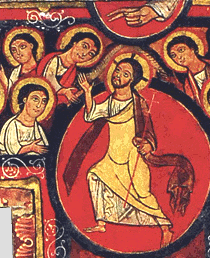
In the upper part, angels sing to Christ and in the extreme upper edge the right hand of the Father is depicted in a semicircle. At the very bottom of the foot of the cross are some apostles, who look up to the Lord with their heads held high. A rooster is depicted next to Christ’s left leg; it is a reference to Peter’s denial and a sign of vigilance.
This certainly does not exhaust the rich content of this crucifix. The Lord has worked salvation for us humans. Whether we become partakers of this salvation is determined by the way in which we stand before Him. This is pictured by the people standing to the left and right of the body of the Crucified.
